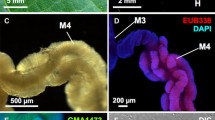Abstract
The outbreak of an infectious disease in captive-bred Lepidoptera can cause death of all the caterpillars within days. A mixed baculoviral–bacterial infection observed among Actias selene (Hübner 1807), the Indian moon moth (Insecta: Lepidoptera: Saturniidae), larvae was characterized and followed by a photographic documentation of the disease progression. The etiological agents were determined using mass spectrometry and polymerase chain reaction (PCR). It appeared that the disease was caused by a mixed infection of larvae with a baculovirus and Morganella morganii. A molecular phylogenetic analysis of the virus and microbiological description of the pathogenic bacterium are presented.





Similar content being viewed by others
References
Altschul SF, Gish W, Miller W, Myers EW and Lipman DJ 1990 Basic local alignment search tool. J. Mol. Biol. 215 403–410
Bergold GH 1953 Insect viruses. Adv. Virus Res. 1 91–139
Cerenius L and Söderhäll K 2004 The prophenoloxidase-activating system in invertebrates. Immunol. Rev. 198 116–126
Cunningham JC and Entwistle PF 1981 Control of sawflies by baculovirus; in Microbial control of pests and plant diseases 1970–1980 (ed) HD Burges (London: Academic Press) pp 379–407
Feng W, Wang X-Q, Zhou W, Liu G-Y and Wan Y-J 2011 Isolation and characterization of lipase-producing bacteria in the intestine of the silkworm, Bombyx mori, reared on different forage. J. Insect Sci. 11 135
Galtier N, Gouy M and Gautier C 1996 SEAVIEW and PHYLO_WIN: two graphic tools for sequence alignment and molecular phylogeny. Comput. Appl. Biosci. 12 543–548
Gouy M, Guindon S and Gascuel O 2010 SeaView version 4: a multiplatform graphical user interface for sequence alignment and phylogenetic tree building. Mol. Biol. Evol. 27 221–224
Gröner A 1986 Specificity and safety of baculoviruses; in The biology of baculoviruses, vol. II. Practical application for insect control (eds) RR Granados and BA Federici (Boca Raton: CRC Press) pp 177–202
Guindon S and Gascuel O 2003 A simple, fast, and accurate algorithm to estimate large phylogenies by maximum likelihood. Syst. Biol. 52 696–704
Guindon S, Lethiec F, Duroux P and Gascuel O 2005 PHYML Online—a web server for fast maximum likelihood-based phylogenetic inference. Nucl. Acids Res. 33 W557–W559
Hamblin S and Tanaka M 2013 Behavioural manipulation of insect hosts by Baculoviridae as a process of niche construction. BMC Evol. Biol. 13 170
Hampson GF 1892 Fauna of British India. Moths. Volume 1 (London: Taylor and Francis, Red Lion Court, Fleet Street) pp 13–14
Jehle JA, Lange M, Wang H, Hu Z, Wang Y and Hauschild R 2006 Molecular identification and phylogenetic analysis of baculoviruses from Lepidoptera. Virology 346 180–193
Lange M, Wang H, Zhihong H and Jehle JA 2004 Towards a molecular identification and classification system of lepidopteran-specific baculoviruses. Virology 325 36–47
Müller HE 1986 Occurrence and pathogenic role of Morganella-Proteus-Providencia group bacteria in human feces. J. Clin. Microbiol. 23 404–405
Nishiwaki H, Ito K, Shimomura M, Nakashima K and Matsuda K 2007 Insecticidal bacteria isolated from predatory larvae of the antlion species Myrmeleon bore (Neuroptera: Myrmeleontidae). J. Invertebr. Pathol. 96 80–88
O'Hara CM, Brenner FW and Miller JM 2000 Classification, identification, and clinical significance of Proteus, Providencia, and Morganella. Clin. Microbiol. Rev. 13 534–546
Page RDM 1996 TREEVIEW: an application to display phylogenetic trees on personal computers. Comput. Appl. Biosci. 12 357–358
Posada D and Crandall KA 1998 MODELTEST: testing the model of DNA substitution. Bioinformatics 14 817–818
Rennie J 1923 Polyhedral disease of Tipula paludosa (Meigen). Proc. R. Phys. Soc. Edinb. A. 20 265–267
Sambrook J, Fritsch EF and Maniatis T 1989 Molecular sloning. A laboratory manual (New York: Cold Spring Harbor Laboratory Press)
Swofford DL 2001 PAUP*: phylogenetic analysis using parsimony (and other methods). Version 4 (Sunderland: Sinauer Associates)
Acknowledgments
The authors thank Carl Marshall from the butterfly farm for his help and assistance. This work was supported by Department of Molecular Biotechnology, Division of Chemistry, University of Gdansk task fund no. 530-8640-D509-14, and Department of Molecular Biology Department, Division of Biology, University of Gdansk task fund no. 530-L140-D242-14.
Author information
Authors and Affiliations
Corresponding author
Additional information
Corresponding editor: Seyed E Hasnain
[Skowron MA, Guzow-Krzemińska B, Barańska S, Jędrak P and Węgrzyn G 2015 A rapidly progressing, deadly disease of Actias selene (Indian moon moth) larvae associated with a mixed bacterial and baculoviral infection. J. Biosci.] DOI 10.1007/s12038-015-9538-0
Rights and permissions
About this article
Cite this article
Skowron, M.A., Guzow-Krzemińska, B., Barańska, S. et al. A rapidly progressing, deadly disease of Actias selene (Indian moon moth) larvae associated with a mixed bacterial and baculoviral infection. J Biosci 40, 487–495 (2015). https://doi.org/10.1007/s12038-015-9538-0
Received:
Accepted:
Published:
Issue Date:
DOI: https://doi.org/10.1007/s12038-015-9538-0




